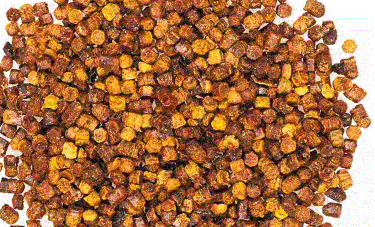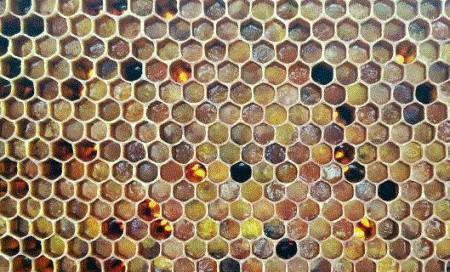How to store bee bread at home
Many buyers and beekeepers have a question: how to store bee bread at home?
Beebread has a complex and unique composition, which has strong medicinal properties and therefore beebread is widely used for the prevention and treatment of many diseases. In this case, the main task is how to store bee bread and how to take bee bread correctly. Let's look at how to store bee bread correctly.
Content
- Organizing the storage of bee bread
- How to store bee bread using traditional technology for storing bee bread in honeycombs
- How to store bee bread using the new technology for storing bee bread in honeycombs
- How to choose bee bread when buying
- Beebread: how to store beebread crumbs
- Bee bread: how to store bee bread in granules
- Shelf life of bee bread
- Video on how to store bee bread
Organizing the storage of bee bread
Beekeepers organize storage of bee bread in several ways, depending on the type of bee bread - honeycombs with bee bread, bee bread in granules, honey bee bread mixture, how to store bee bread at home even depends on when and how the honeycombs with bee bread are obtained.
Interestingly, honeycombs with beebread are stored well only if the beebread in the cells of the combs is filled with honey on top and the cells are sealed with wax caps. But this method of storing beebread is labor-intensive and beekeepers rarely use it. Also, honeycombs with open beebread are generously covered with powdered sugar, which protects the beebread from molding and drying out. But this method is also rarely used due to its high cost.
To prevent bee bread from being damaged by wax moths or beebread mites, preventive treatment of the honeycombs is carried out periodically.
If the beekeeper receives honeycombs with beebread after pumping out the honey, then in this case the question of how to store beebread is solved in the following way: it is necessary to initially dry the honeycombs from the remaining honey. Frames with beebread are placed for the bees to dry; after drying, when the bees take all the remaining honey, pieces of honeycomb with bee bread are cut out of the frames - beebread cuttings.
If beebread is obtained using a special technology (as described in the article), you get honeycombs with beebread without honey and therefore there is no need to pump out the honey and then dry the honeycombs. In this case, beebread cuts are cut immediately.
As a rule, the preparation of beebread cuttings in the apiary is carried out in the spring and summer. At this time, the beekeeper has a lot of work and he has no time to beat bee bread from bee bread cuttings, unless he hires additional workers, so it is necessary to save bee bread cuttings until winter.
At the next stage, the question arises - how to store bee bread, where to store it, how to preserve bee bread clippings from wax moths and mice for a long time?
How to store bee bread using traditional technology for storing bee bread in honeycombs
Traditionally, beebread cuttings are stored in a dry room, at a temperature of 8-10 ° C. Foreign odors and rodents, insect pests and bees should not penetrate into the room. If it is not possible to lower the temperature in the room, then to protect beebread cuttings from damage by wax moths, open containers with acetic acid of 75% concentration are placed in the room. The amount of acid is taken at the rate of 5-10 grams of acid per 1 cubic meter of room. (Precautions must be taken when working with acetic acid.)
Honeycombs with beebread can be stored in cases and hives equipped with bottoms and lids. In this case, the container with acid is placed under the lid, closing the hive hermetically.
How to store bee bread using the new technology for storing bee bread in honeycombs
How to store bee bread at home Recently, the technology for storing bee bread in honeycombs has been greatly simplified. For storage, beebread cuttings are placed in clean plastic bags, which are tightly tied and stored in the basement, omshanik, or winter hut. Regular 60-liter garbage bags work well; each one just fits a Dadan frame.
Plastic bags prevent foreign odors and moisture from entering the bee bread.
The fight against mice and other rodents is carried out in the traditional way (poisoned wheat is periodically spread out). To combat wax moths, low temperatures are sufficient. At temperatures up to 10 degrees, wax moths do not reproduce and you don’t have to worry about storing beebread. To prevent the appearance of mold, when storing bee bread in honeycombs, it should be dried to 14-15% humidity.
How to choose bee bread when purchasing
Based on the technology for obtaining bee bread, when purchasing bee bread, buyers need to take into account the timing of the purchase of bee bread and choose good quality bee bread.
It is better to buy bee bread in the summer, from a beekeeper, thereby avoiding such risks as buying old, last year's bee bread. In what form to buy bee bread - bee bread in honeycombs, bee bread in granules, crushed bee bread or honey bee bread paste, the buyer must determine for himself, based on his preferences. It is quite an acceptable option to buy a honeycomb with beebread, for storing beebread, sprinkle it with powdered sugar and put it in the refrigerator in an airtight package. As needed the bee bread is removed from the honeycomb, and the rest of the bee bread is stored further.
When buying bee bread, the most important thing to pay attention to is the consistency, color, and taste of bee bread. If you take a bee bread granule and it turns out that it is very soft and easily deforms when squeezed with your fingers, you can rest assured that the bee bread has become damp during storage and is unsuitable for use. Mold begins to develop in damp beebread, even if no plaque is visible. If the bee bread granule is like stone and very dark, then most likely it was dried at elevated temperatures. Fresh bee bread can be rock-like or moderately hard, but its color is lighter. Fresh bee bread can have a brown or light brown color interspersed with other colors (red, purple, etc.), it all depends on the color of the pollen pollen that the bees collected; old bee bread has a darker color (usually dark brown). It is believed that the light yellow color of bee bread may indicate its immaturity. Fresh bee bread has a sweetish-sour taste, sometimes with bitterness, while old bee bread tastes like dust, retaining sourness, but without sweetness. Of course, the taste of bee bread will be influenced by the taste of the pollen that the bees collected, for example, from willow the pollen is sweet, from cruciferous plants it has a noticeable bitterness. But if the bee bread tastes bitter, this may also indicate that the bee bread became damp during storage or was initially poorly dried and molding processes began in it.
Having chosen high-quality bee bread, the buyer needs to take care of the conditions for storing bee bread at home - where to store bee bread and how to store bee bread.
Beebread: how to store beebread crumbs
Beebread crumbs are normal bee bread that retain all the valuable properties, but instead of bee bread granules in a very fine fraction. Beebread crumbs are obtained through the process of breaking down honeycombs to produce beebread granules. But since beebread crumbs have an unattractive appearance in their pure form, they are rarely sold.
How to store bee bread at home: Preserve crushed bee bread in the same way as pollen is preserved. You can make honeydew paste. You can also process pieces of honeycomb with beebread into honey bee paste by grinding them in a meat grinder and adding mature honey.
Bee bread: how to store bee bread in granules
bee bread how to store bee bread granules Storing bee bread in granules is similar to storing other dry products. To do this, you need a dry, ventilated room. Bee bread in granules is stored in sealed containers. Where to store bee bread? Storing bee bread at home in the refrigerator is strictly not recommended; storing bee bread in an open container - too high humidity will lead to moldy bee bread. In the refrigerator, it is necessary to store bee bread in a glass or plastic tightly closed container, but under no circumstances in the freezer or at near-zero temperatures, just put the jar of bee bread in a regular compartment of the refrigerator or a shelf in the refrigerator door.
There is one caveat: to obtain beebread in granules, some beekeepers freeze honeycombs with beebread; after freezing, the honeycombs crumble very easily and quickly, wax crumbs and pieces of cocoons are easily separated from beebread. However, bee bread should absolutely not be frozen if it is planned to be taken for treatment. The argument that beebread overwinters in the hollow of wild bees and they consume it in the spring is incorrect. Bees warm their home, and in the whole hive in winter it is not - 30 C, but not 0 C. Bees can eat bee bread after freezing, it is protein food for them, but for people bee bread, the granules of which are obtained without freezing the honeycombs, is better suited.
Shelf life of bee bread
How long does bee bread last? The shelf life of bee bread depends on storage conditions, whether the mature bee bread was removed from the honeycomb or not; the shelf life of bee bread, if it is a good mature bee bread and stored in a dry place, reaches 17 years, and it does not lose its biological qualities. But as a rule, it is not worth storing bee bread for more than one year. Over time, beebread darkens, loses its taste, the taste begins to resemble dust, neither sweet nor bitter. The beneficial properties also decrease over time, especially if the bee bread was stored incorrectly.

